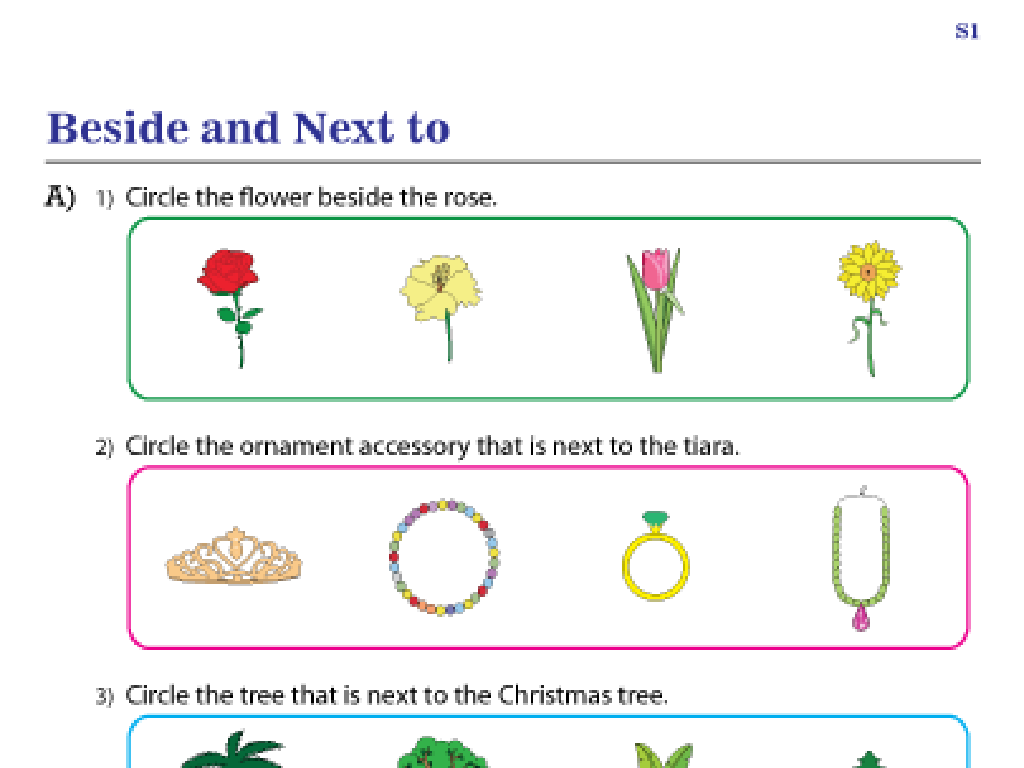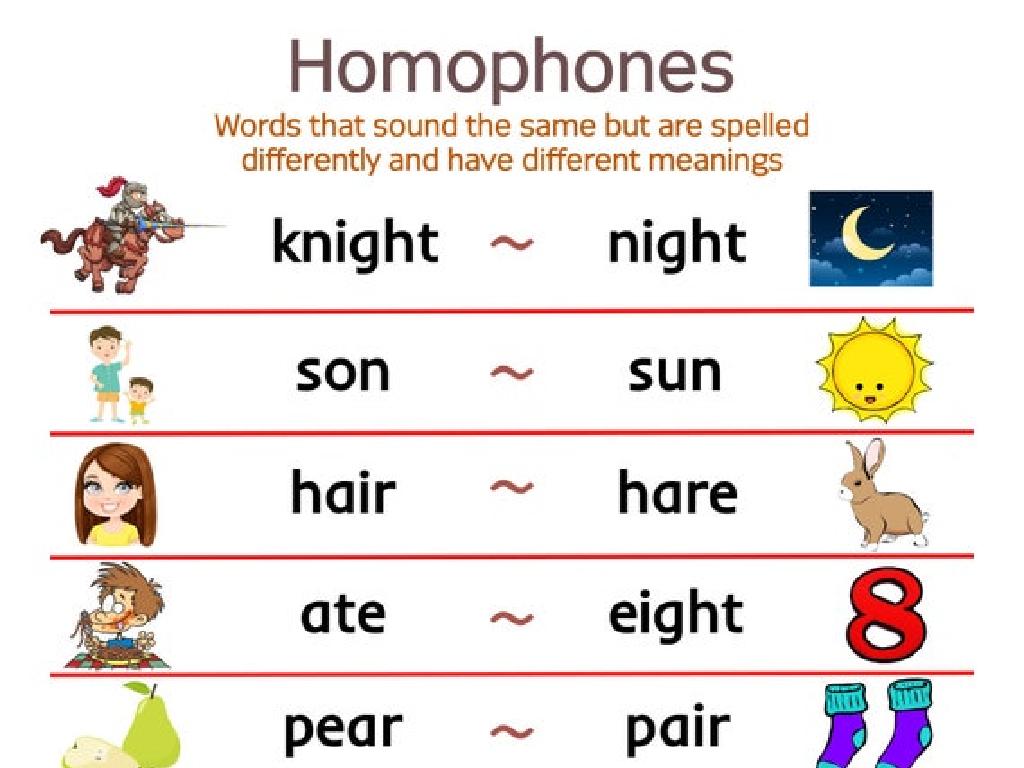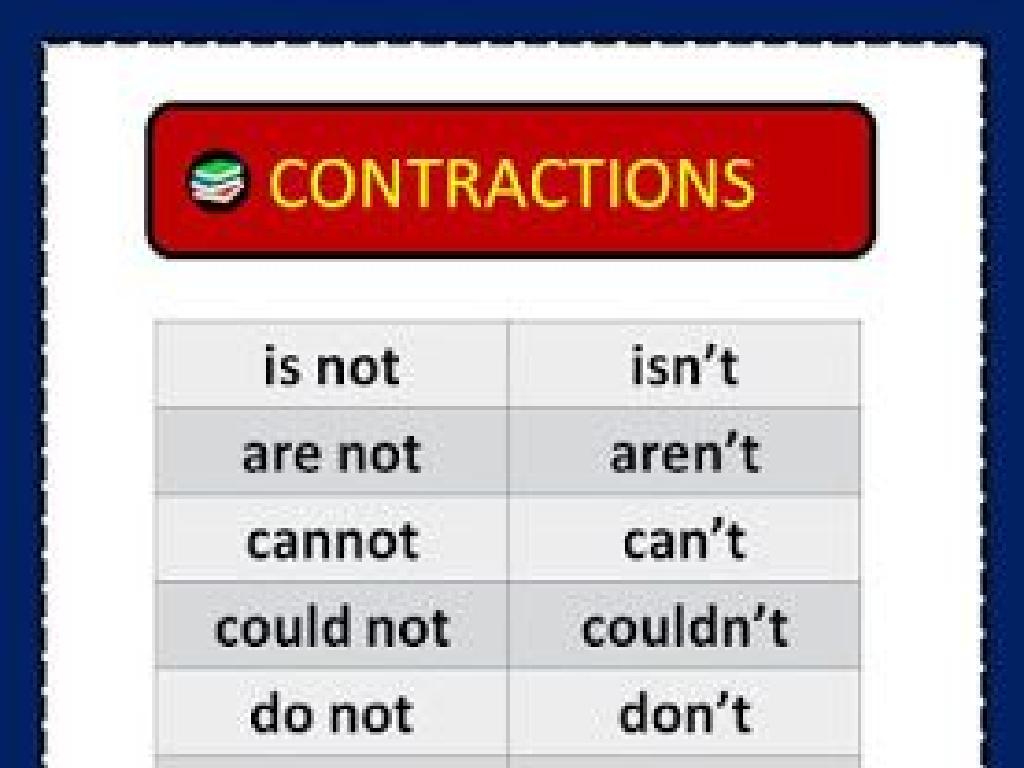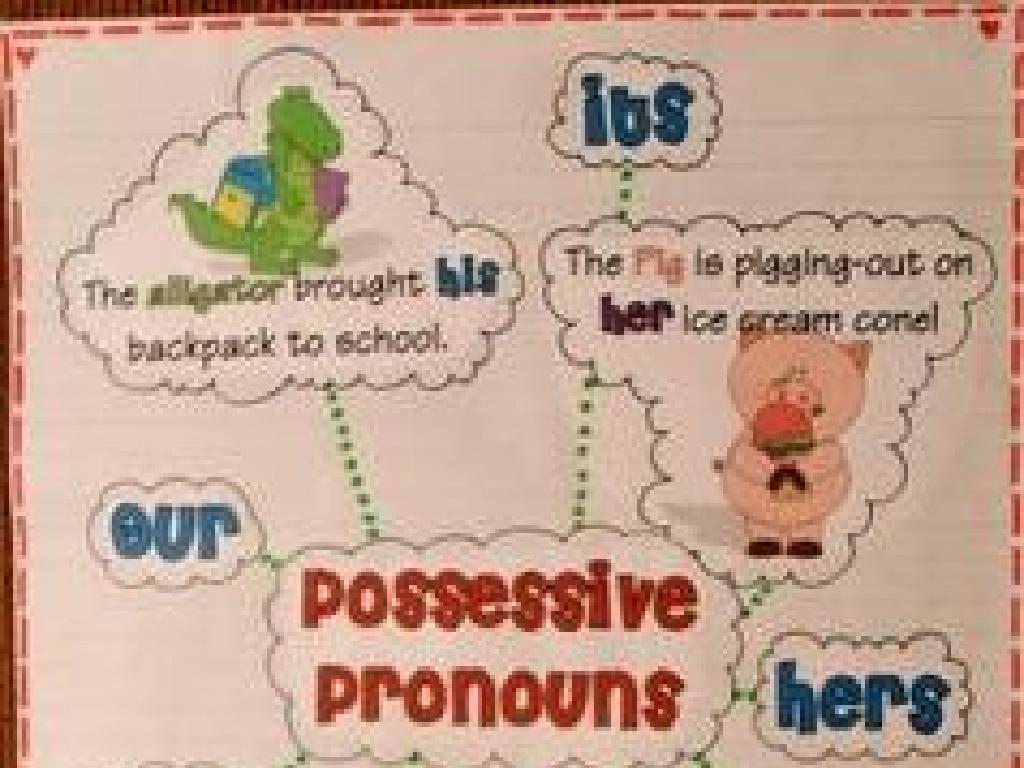Form And Use The Regular Past Tense
Subject: Language arts
Grade: Fourth grade
Topic: Verb Tense
Please LOG IN to download the presentation. Access is available to registered users only.
View More Content
Welcome to Verb Tenses!: Exploring the Past
– Understanding verb tenses
– Verb tenses tell us when an action happens
– Defining a verb
– A verb is an action word like ‘run’, ‘jump’, or ‘think’
– Exploring the past tense
– Past tense verbs tell about actions that have already happened
– Regular past tense formation
– Add ‘ed’ to most verbs to show past action, like ‘jump’ becomes ‘jumped’
|
This slide introduces the concept of verb tenses, focusing on the past tense. Begin by explaining that verb tenses indicate the timing of an action. Clarify what a verb is by providing familiar examples. Emphasize that the past tense is used to describe actions that are completed. Teach students the rule for converting regular verbs to their past tense form by adding ‘ed’ at the end. Provide examples and encourage students to think of verbs they use daily and how they would change in the past tense. This will set the foundation for more practice with past tense verbs in class.
Exploring the Past Tense
– Understanding past tense
– Past tense describes actions done before now
– When to use past tense
– Use it for actions that are finished
– Recognizing past tense verbs
– Words like ‘walked’, ‘jumped’, ‘played’
– Examples of past tense
– ‘I walked to school’, ‘She jumped high’, ‘We played games’
|
The past tense is a verb tense used to talk about actions that have already happened. During the lesson, explain that we use the past tense to discuss things that are completed, which means they are not happening right now. Provide students with clear examples of past tense verbs, emphasizing the -ed ending that many regular verbs have in this tense. Encourage students to think of actions they did yesterday or earlier in the day and to practice turning present tense verbs into past tense. For example, ‘Today I walk to school, but yesterday I walked to school.’ This slide will help students recognize and form regular past tense verbs, a fundamental skill in English grammar.
Forming the Regular Past Tense
– Add ‘-ed’ to make past tense
– ‘Walk’ turns into ‘walked’
– Example: I walk to school every day. Yesterday, I walked.
– ‘Jump’ changes to ‘jumped’
– Example: She jumps rope during recess. She jumped higher today.
– Practice with more verbs
|
This slide introduces the basic rule for forming the regular past tense in English, which is adding ‘-ed’ to the base form of most verbs. Start by explaining that the past tense is used to describe actions that have already happened. Use ‘walk’ and ‘jump’ as clear examples to show the rule in action. Encourage students to think of verbs they use daily and practice converting them into the past tense. Provide additional verbs for practice, such as ‘play’ to ‘played’ or ‘look’ to ‘looked’, and ask students to create sentences using these verbs in the past tense to reinforce the concept.
Spelling Rules for Regular Past Tense
– Add ‘d’ to verbs ending in ‘e’
– For example, ‘love’ becomes ‘loved’
– Change ‘y’ to ‘i’, then add ‘ed’
– ‘Cry’ turns into ‘cried’
– Double final consonant, add ‘ed’
– Like ‘stop’ changes to ‘stopped’
– Practice with examples
|
This slide is aimed at teaching fourth graders the spelling rules for forming the regular past tense of verbs. Start by explaining that most verbs in the past tense end with ‘-ed’. However, there are some spelling rules to remember. If the verb already ends with an ‘e’, we simply add a ‘d’. When a verb ends in a consonant followed by ‘y’, we change the ‘y’ to ‘i’ and then add ‘ed’. For verbs with a short vowel followed by a consonant, we double the final consonant before adding ‘ed’. Provide students with a list of verbs and have them practice converting them into the past tense using these rules. Encourage them to come up with additional examples and write sentences using the past tense verbs they have formed.
Irregular Past Tense Verbs
– Some verbs break the rules
– Examples: go – went, have – had
– ‘go’ becomes ‘went’, not ‘goed’
– Memorization is key for these
– Practice makes perfect with these tricky verbs
– They are unique exceptions
– Unlike ‘walked’ or ‘jumped’, they change form
|
This slide introduces students to irregular past tense verbs, which do not follow the standard ‘-ed’ ending rule. Provide examples of common irregular verbs and their past tense forms to illustrate the concept. Emphasize the importance of memorization, as these verbs do not adhere to regular patterns. Encourage students to practice using these verbs in sentences and to create flashcards for study aids. During class, engage students with activities that involve filling in the blanks with the correct form of irregular verbs and creating their own sentences using these verbs to reinforce learning.
Practice Time: Past Tense Verbs
– Transform present to past tense
– Teacher writes a verb on the board
– Example: ‘jump’ becomes ‘jumped’
– Students write the past tense form
– Remember to add ‘ed’ to most verbs
– Class reviews answers together
– This helps us learn from each other
|
This slide is for an interactive classroom activity focused on converting present tense verbs to their regular past tense forms. The teacher will write verbs on the board one at a time, and students will be tasked with writing the past tense of each verb on their own. Afterward, the class will come together to review and correct the answers, fostering a collaborative learning environment. It’s important to remind students that for most regular verbs, the past tense is formed by adding ‘ed’ at the end. However, be prepared to explain common exceptions and irregular verbs. This activity will help reinforce the lesson and give students the opportunity to practice and solidify their understanding of regular past tense verb forms.
Let’s Play: Verb Tense Matching Game
– Learn about past tense verbs
– Match present to past tense forms
– For example, ‘jump’ matches with ‘jumped’
– Work with a partner
– Find many correct matches
– The pair with the most matches wins!
|
This interactive game is designed to help students understand and practice the concept of regular past tense verbs. Students will work in pairs to match present tense verbs with their past tense counterparts. Provide students with a list of present tense verbs and a separate list of their past tense forms, mixed up. Encourage collaboration as they discuss and decide on the correct matches. This activity will reinforce their understanding of verb tense changes in a fun and engaging way. As an extension, ask students to use each matched pair in a sentence to demonstrate their understanding of the past tense in context. Prepare a small reward for the pair that finds the most correct matches to motivate participation.
Past Tense Storytelling Activity
– Write a short story with past verbs
– Include 5 verbs changed to past tense
– Share your story with a classmate
– Take turns reading to each other
– Discuss the best parts of the stories
– Give positive feedback on story details
– Reflect on the use of past tense
|
This activity is designed to help students practice using regular past tense verbs in a fun and interactive way. They will write their own short stories, incorporating at least five verbs that they have changed to the past tense form. After writing, students will pair up to read their stories to each other, providing an opportunity to practice speaking and listening skills. Encourage them to discuss what they enjoyed about each other’s stories, focusing on the content and the correct use of past tense verbs. This peer feedback session is valuable for building confidence and reinforcing the lesson. Conclude with a reflection on how the past tense was used to describe events that have already happened.
Class Activity: Time Travel Story
– Imagine using a time machine
– Write about your adventure
– Describe where you went and actions you took
– Use regular past tense verbs
– Words like ‘walked’, ‘talked’, and ‘played’
– Share your story with the class
|
In this engaging class activity, students will use their imagination to write a short story as if they’ve traveled through time. Encourage them to think creatively about where they would go and what they would do. The focus is on practicing the regular past tense form of verbs, so remind them to add ‘-ed’ to the end of regular verbs to show that the action happened in the past. After writing, students will have the opportunity to share their stories with the class, allowing them to practice speaking in the past tense as well. Possible activities for different students could include traveling to different time periods, meeting historical figures, or experiencing past events firsthand. This will help reinforce their understanding of verb tenses in a fun and interactive way.
Review & Homework: Past Tense Practice
– Recap today’s past tense lesson
– Homework: 10 past tense verbs
– Find verbs and change to past tense
– Use a favorite book for verbs
– Example: ‘jump’ becomes ‘jumped’
– Share your verbs next class
|
This slide is meant to summarize the day’s lesson on regular past tense verbs and to assign homework that reinforces this concept. During the review, revisit the rule for adding ‘-ed’ to regular verbs to form the past tense. For homework, students should look for verbs in any book they enjoy and write those verbs in the past tense. Encourage them to think about the action that happened and how to show it’s completed. In the next class, students will have the opportunity to share their findings, allowing them to learn from each other and reinforce their understanding of past tense verbs.






